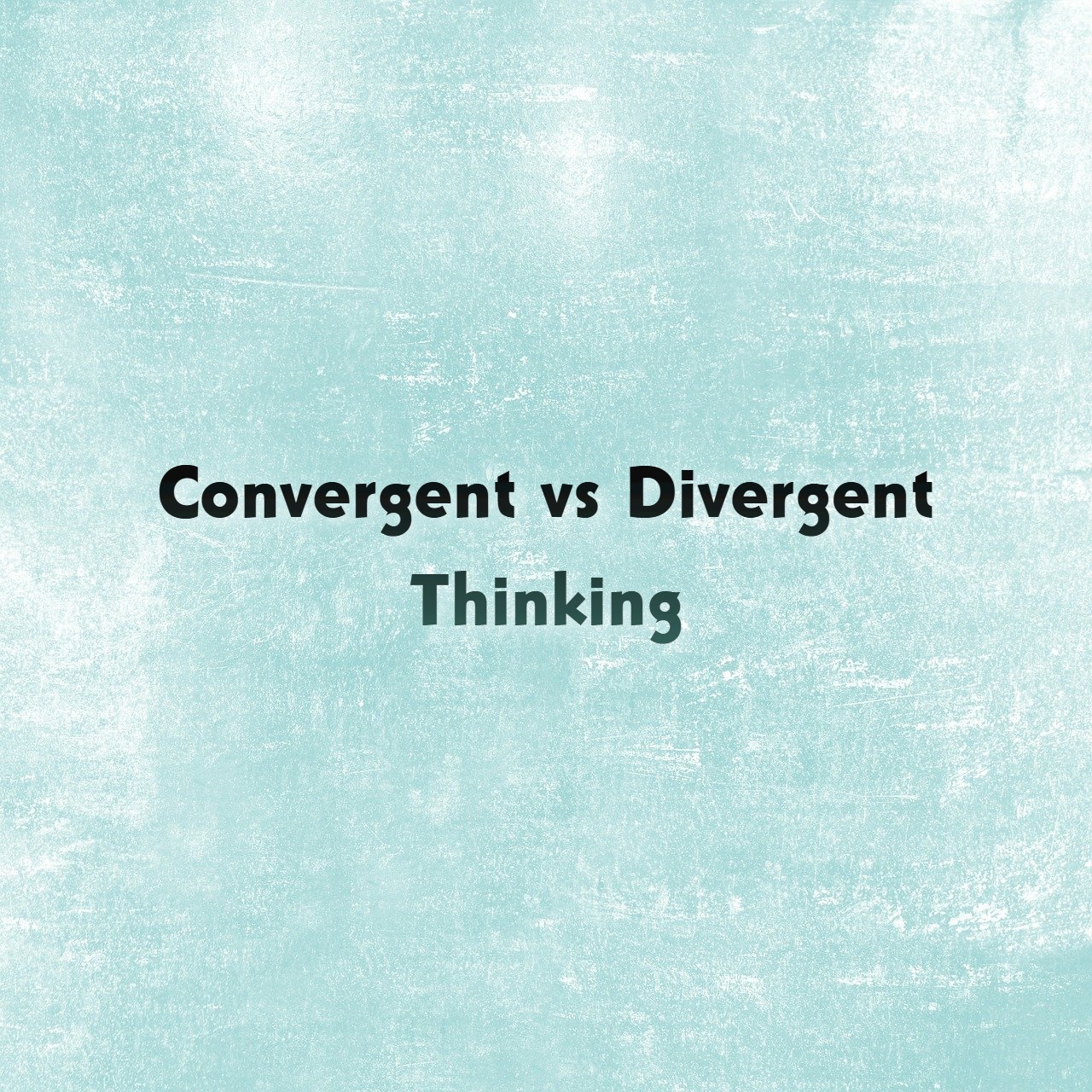Convergent vs Divergent Thinking
Human thought processes are fascinatingly diverse, and two prominent modes of thinking often discussed are convergent and divergent thinking. These cognitive approaches play pivotal roles in creativity, problem-solving, and innovation. While they might seem contradictory, they are complementary and essential for navigating complex challenges in various domains.

These two approaches represent distinct pathways through which our minds navigate the complexities of problem-solving, creativity, and decision-making. Convergent thinking is akin to a focused beam of light, honing in on a single, precise solution to a well-defined problem. It operates within the confines of established rules and logic, systematically evaluating options to arrive at the most optimal outcome. For example, when solving a mathematical equation or troubleshooting a technical issue, individuals rely on convergent thinking to methodically analyze information and reach a definitive conclusion.
Conversely, divergent thinking resembles a bubbling cauldron of creativity, bubbling with an array of ideas, possibilities, and perspectives. It thrives on exploration, experimentation, and imagination, embracing ambiguity and complexity as catalysts for innovation. Consider the process of brainstorming, where participants generate a multitude of ideas without judgment or constraint, allowing for the emergence of novel solutions and insights. While convergent thinking emphasizes precision and efficiency, divergent thinking champions flexibility and originality, encouraging individuals to think outside the box and challenge conventional wisdom. These contrasting modes of thought are not mutually exclusive but rather complementary, each contributing unique strengths to the problem-solving process.
By understanding the characteristics and applications of convergent and divergent thinking, we can harness their synergistic power to navigate the ever-evolving landscape of challenges and opportunities in our personal and professional lives.
Understanding Convergent Thinking:
Convergent thinking is a focused, linear thought process aimed at finding a single, correct solution to a well-defined problem. It involves narrowing down possibilities and evaluating them systematically to arrive at the most appropriate answer. This type of thinking relies heavily on logic, analysis, and deductive reasoning.
In educational settings, convergent thinking is often emphasized through standardized testing and structured assessments where there is a clear right or wrong answer. It is prevalent in fields like mathematics, engineering, and computer science, where precise solutions are paramount. Convergent thinking is also indispensable in decision-making processes, guiding individuals and organizations to make informed choices based on available data and objectives.
Key Characteristics of Convergent Thinking:
- Logic and Order: Convergent thinking follows a logical sequence of steps, allowing for a systematic approach to problem-solving.
- Precision: It focuses on arriving at a definitive solution, requiring accuracy and attention to detail.
- Critical Analysis: Evaluating and eliminating alternatives based on established criteria is central to convergent thinking.
- Goal-Oriented: The primary objective is to reach a specific conclusion or outcome within defined parameters.
Applications of Convergent Thinking:
- Scientific Research: Convergent thinking is essential for formulating hypotheses, designing experiments, and analyzing data in scientific inquiry.
- Engineering and Technology: Engineers employ convergent thinking to devise efficient solutions to technical challenges, ensuring reliability and functionality.
- Business Strategy: In strategic planning, convergent thinking aids in assessing market dynamics, identifying opportunities, and making informed decisions to achieve organizational goals.
Understanding Divergent Thinking:
In contrast to convergent thinking, divergent thinking is expansive, nonlinear, and unconstrained by predefined rules or limitations. It involves generating multiple ideas, perspectives, and solutions, often through free association and creative exploration. Divergent thinking thrives on spontaneity, imagination, and openness to unconventional possibilities.
Divergent thinking is at the heart of creativity and innovation, driving breakthroughs in art, literature, science, and technology. It encourages individuals to think outside the box, challenge assumptions, and envision alternative scenarios. By embracing ambiguity and complexity, divergent thinking fosters a culture of experimentation and risk-taking, essential for tackling complex problems with no clear-cut answers.
Key Characteristics of Divergent Thinking:
- Creativity: Divergent thinking encourages the generation of original ideas and novel perspectives, fostering innovation and artistic expression.
- Flexibility: It allows for exploration of diverse pathways and solutions, promoting adaptability and agility in problem-solving.
- Open-Mindedness: Divergent thinkers are receptive to unconventional ideas and perspectives, embracing ambiguity and uncertainty.
- Playfulness: Playful experimentation and exploration are integral to divergent thinking, fostering a spirit of curiosity and discovery.
Applications of Divergent Thinking:
- Creative Arts: Divergent thinking fuels artistic endeavors, inspiring composers, writers, and visual artists to push boundaries and explore new forms of expression.
- Product Design: Designers leverage divergent thinking to conceptualize innovative products and user experiences that resonate with diverse audiences.
- Brainstorming and Ideation: In collaborative settings, divergent thinking techniques such as brainstorming stimulate idea generation and problem-solving by encouraging uninhibited creativity.
- Entrepreneurship: Entrepreneurs harness divergent thinking to identify market gaps, conceptualize disruptive business models, and drive innovation in diverse industries.
Why you need both types of Thinking
Both convergent and divergent thinking are indispensable facets of cognitive processing, each offering unique strengths that complement and enrich the problem-solving process. Convergent thinking provides the structure and focus necessary to distill complex problems into manageable components, enabling individuals to analyze information systematically and arrive at a definitive solution.
It emphasizes precision, logic, and efficiency, guiding decision-making processes in situations where clear-cut answers are required. Without convergent thinking, there would be a lack of direction and coherence in problem-solving endeavors, hindering the ability to navigate through intricate challenges with clarity and purpose.
On the other hand, divergent thinking serves as the catalyst for creativity and innovation, fostering a climate of exploration, experimentation, and open-mindedness. By encouraging individuals to break free from conventional thinking patterns and explore a multitude of ideas and perspectives, divergent thinking expands the realm of possibilities and generates novel insights. It fuels the creative process by challenging assumptions, stimulating curiosity, and inspiring unconventional solutions to complex problems. Without divergent thinking, innovation would stagnate, and opportunities for growth and advancement would remain untapped, as individuals would be confined to conventional modes of thinking that limit their potential for originality and ingenuity.

Thus, the integration of both convergent and divergent thinking is essential for fostering a holistic approach to problem-solving, decision-making, and creativity, empowering individuals to navigate through the complexities of the modern world with agility, insight, and innovation.
Conclusion:
Convergent and divergent thinking represent two fundamental modes of cognitive processing, each with its distinct characteristics, applications, and benefits. While convergent thinking emphasizes logic, analysis, and precision in arriving at a single solution, divergent thinking fosters creativity, exploration, and innovation by generating multiple possibilities and perspectives. By leveraging the synergy between these two approaches, individuals and organizations can unlock their full potential for tackling complex challenges and driving meaningful change in a rapidly evolving world. Embracing both convergent and divergent thinking enables us to navigate uncertainty, embrace ambiguity, and unleash our creative and problem-solving prowess to shape a brighter future.

